
Temperatures on Earth Google Doc
- Subject:
- Physical Science
- Material Type:
- Lesson
- Author:
- Sara Catanese
- Date Added:
- 03/11/2021

Temperatures on Earth Google Doc

We will cover fundamentals of ecology, considering Earth as an integrated dynamic system. Topics include coevolution of the biosphere, geosphere, atmosphere and oceans; photosynthesis and respiration; the hydrologic, carbon and nitrogen cycles. We will examine the flow of energy and materials through ecosystems; regulation of the distribution and abundance of organisms; structure and function of ecosystems, including evolution and natural selection; metabolic diversity; productivity; trophic dynamics; models of population growth, competition, mutualism and predation. This course is designated as Communication-Intensive; instruction and practice in oral and written communication provided. Biology is a recommended prerequisite.
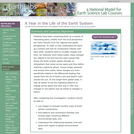
Students have been examining Earth as a system of interacting parts, initially from the local perspective but more recently from the regional and global perspectives. In order to fully understand the Earth as a system and how its components interact with each other, students need to consider change over time. On relatively short times scales, these changes are related to the fact that the solar energy that drives the Earth system passes through an atmosphere that varies across space and time before reaching a spinning sphere. Across longer seasonal and annual time scales, these changes are more specifically related to the differential heating that results from the tilt of Earth's axis and Earth's orbit around the sun. At this longer-term global scale, it may be easier to see the repeating patterns of change across space and time and to infer how changes in one sphere may be linked to changes in others.
(Note: this resource was added to OER Commons as part of a batch upload of over 2,200 records. If you notice an issue with the quality of the metadata, please let us know by using the 'report' button and we will flag it for consideration.)
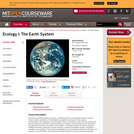
" We will cover fundamentals of ecology, considering Earth as an integrated dynamic system. Topics include coevolution of the biosphere, geosphere, atmosphere and oceans; photosynthesis and respiration; the hydrologic, carbon and nitrogen cycles. We will examine the flow of energy and materials through ecosystems; regulation of the distribution and abundance of organisms; structure and function of ecosystems, including evolution and natural selection; metabolic diversity; productivity; trophic dynamics; models of population growth, competition, mutualism and predation. This course is designated as Communication-Intensive; instruction and practice in oral and written communication provided. Biology is a recommended prerequisite."

Students will develop a scale model of the sun, Earth, and moon system based on a one-meter sun. Students will first interact with a technology-based scaled model and view a video clip on scaling the solar system. Students will then scale the diameter of the Earth and moon, as well as the distance from the Earth to the sun, and from the Earth to moon. Students will be required to utilize mathematical skills, such as division, rounding, and metric system conversions. After scaling the diameters and distances, students will create the scaled model. This lesson results from a collaboration between the Alabama State Department of Education and ASTA.

A learning activity for the "All About Earth: Our World on Stage" book in the Elementary GLOBE series. In pairs, students will create experimental conditions in terrariums in order to study what plants need to live. Variables to study include the presence or absence of soil, water, and sunlight. Students will record the growth of radish plants as well as observations of "the water cycle" in their terrariums. At the conclusion of their experiments, students will share their results with the class and discuss how water, Earth materials, and air are all necessary to support living things. The purpose of the activity is to acquaint students with the hydrosphere, geosphere, atmosphere, and biosphere more closely, to have students use microcosms to study natural phenomena, and to introduce students to the concept of a "fair test" in a scientific investigation. After completing this activity, students will know about the importance of the hydrosphere, geosphere, and atmosphere in supporting the biosphere. They will learn how to set up "fair test", record detailed observations, use drawings as scientific records, make sense of experimental results, and share them publicly.
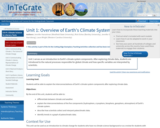
Unit 1 serves as an introduction to Earth's climate system components. After exploring climate data, students are introduced to the natural processes responsible for global climate and how specific variables are interpreted by scientists.
(Note: this resource was added to OER Commons as part of a batch upload of over 2,200 records. If you notice an issue with the quality of the metadata, please let us know by using the 'report' button and we will flag it for consideration.)
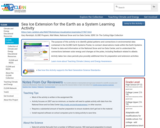
The purpose of this activity is to identify global patterns and connections in environmental data contained in the GLOBE Earth Systems Poster, to connect observations made within the Earth Systems Poster to data and information at the National Snow and Ice Data Center, and to understand the connections between solar energy and changes at the poles, including feedback related to albedo.

MS-ESS2-1 Earth's SystemsDevelop a model to describe the cycling of Earth's materials and the flow of energy that drives this process.MS-ESS2-2 Earth's SystemsConstruct an explanation based on evidence for how geoscience processes have changed Earth's surface at varying time and spatial scales.MS-ESS3-1 Earth and Human ActivityConstruct a scientific explanation based on evidence for how the uneven distributions of Earth's mineral, energy, and groundwater resources are the result of past and current geoscience processes.
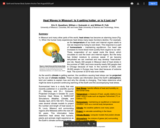
Earth & Human Body Systems Anchor Text
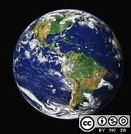
Earth is the third planet from the Sun and the only astronomical object known to harbor life. According to radiometric dating estimation and other evidence, Earth formed over 4.5 billion years ago. Earth's gravity interacts with other objects in space, especially the Sun and the Moon, which is Earth's only natural satellite. Earth orbits around the Sun in 365.256 solar days, a period known as an Earth sidereal year. During this time, Earth rotates about its axis 366.256 times, that is, a sidereal year has 366.256 sidereal days. Earth's axis of rotation is tilted with respect to its orbital plane, producing seasons on Earth. The gravitational interaction between Earth and the Moon causes tides, stabilizes Earth's orientation on its axis, and gradually slows its rotation. Earth is the densest planet in the Solar System and the largest and most massive of the four rocky planets.
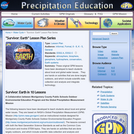
This series of ten lessons has been developed to teach students about local and global water issues. They are based on NASA’s Global Precipitation Measurement (GPM) Mission. The activities are done largely outdoors and include scientific data collection and analysis and integrate technology. Many of the lessons involve data collected based on protocols from the GLOBE Program. Each lesson is designed to take one hour; the lessons build on each other, but can also be used independently. Each lesson topic includes a lesson plan, PowerPoint presentation, student capture sheet and capture sheet answer guide.
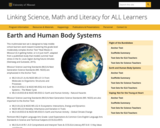
This multimodal text set is designed to help middle school learners work toward mastering the grade-level moderately complex Anchor Text “Heat Waves in Missouri (Is it getting hotter, or is it just me?)”, adapted from a published study that models summer heat stress in the St. Louis region during future climates (Steinweg and Gutowski, 2015).

Elementary school lessons utilize local phenomenon and are organized by grade level. By organizing instruction around local phenomenon, students are provided with a reason to learn shifting the focus from learning about a disconnected topic to figuring out why or how something happens. #Going 3D with GRC

This video segment adapted from NASA's Goddard Space Flight Center discusses how a drought can have negative effects locally, for example by increasing the number of forest fires, and also globally, for example by impacting air quality thousands of miles away.
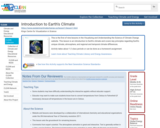
This is the first of nine lessons in the Visualizing and Understanding the Science of Climate Change website. This lesson is an introduction to Earth's climate and covers key principles regarding Earth's unique climate, atmosphere, and regional and temporal climate differences.

Students build a model of the Sun-Earth-Moon system, exploring how the Moon revolves around the Earth, and the Earth around the Sun. Students play a memory game and learn some characteristics about the three objects.

This 24 minute planetarium show teaches about meteors, meteorites, asteroids, and comets. The show was created for fulldome theaters, but is also available on DVD to be shown in flat version for TVs and computer monitors, and can be freely viewed online. It shows the effects of the Chixulub and Tungusta events, plus the Pallasite impact that resulted in the Brenham meteorite fall, and describes ways that asteroid hunters seek new objects in the solar system, and how ground penetrating radar is used to find meteorites that have survived to the Earth's surface. Narrated by astronaut Tom Jones, it also discusses ways that humans might try to deflect an asteroid or comet that is on a collision course with Earth. The show was created for informal science venues (digital planetariums); it is also useful as supplemental material for middle school science. Impact Earth is available for free if presented directly from the Space Update site (widescreen or fisheye views linked from YouTube). Otherwise, a DVD of the show can be purchased for $10.

How are we connected to the patterns we see in the sky and space? Students develop models for the Earth-Sun and Earth-Sun-Moon systems that explain some of the patterns in the sky that they have identified, including seasons, eclipses, and lunar phases. They investigate a series of related phenomena motivated by their questions and ideas for investigations.
This unit is part of the OpenSciEd core instructional materials for middle school.

Our planet is becoming hot. In fact, Earth may be warming faster than ever before. This warming will challenge society throughout the 21st century. How do we cope with rising seas? How will we prepare for more intense hurricanes? How will we adapt to debilitating droughts and heat waves? Scientists are striving to improve predictions of how the environment will change and how it will impact humans. Earth in the Future: Predicting Climate Change and Its Impacts Over the Next Century is designed to provide the state of the art of climate science, the impact of warming on humans, as well as ways we can adapt. Every student will understand the challenges and opportunities of living in the 21st century.